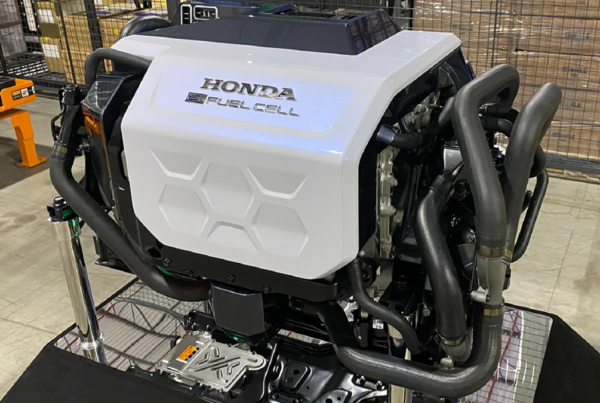
After a decades-long experimentation phase, hydrogen mobility is poised to take a decisive turn towards deployment.
As such, manufacturers of hydrogen systems must meet a dual challenge: to successfully industrialise their products, while maintaining agility in order to meet the expectations of a market that is still not quite mature. Symbio, now a subsidiary of the Michelin Group, has all the assets to achieve its ambition.
From thousands to millions. Nearly 2,000 trucks and more than 20,000 light commercial vehicles announced for France by 2028, more than one million vehicles for China and nearly double for Korea by 2030 while hydrogen technology is recognised as a Strategic Value Chain in Europe… After a decades-long experimentation phase – with the first vehicles having surfaced in the 1980s – hydrogen mobility is now poised to take a decisive tun toward deployment. To date, only 6,500 hydrogen vehicles are in circulation worldwide, including nearly 300 Renault Kangoo ZEH2 equipped by Symbio, a subsidiary of the Michelin Group.
Two factors in particular explain this progress. First, there is the now widely shared and accepted awareness on the necessary development of electromobility to meet several major challenges: that of improving air quality, the fight against global warming, the development of renewable energies and energy efficiency, and a reduction of the economic dependence on fossil fuels. The second is the recognition of complementing battery-powered and hydrogen fuel cell vehicles to meet a maximum of various uses. These two factors explain why many countries have set out ambitious plans for the deployment of hydrogen mobility (China, Korea, Japan, etc.) and that more and more car manufacturers are integrating hydrogen into their strategy.
The challenge of “agility in industrialisation”. To this end, manufacturers of hydrogen systems must quickly establish a production method to increase their annual volumes by 2030 on several levels:
– Hundreds of thousands of stacks for the lorry industry
– Nearly one million stacks for the automotive industry
– Hundreds of thousands for commercial vehicles – from the small Kangoo to the van.
Such volumes will indeed divide by 20 the price of the hydrogen stack and components, by simply increasing capacities, and therefore meet market expectations.
An additional challenge: this increase in capacity should not hinder agility. Stakeholders must reduce both the time of marketing and costs on several segments at the same time, even if maturity levels are different! So, it is important that the decision process remains brief and largely in the hands of “those who perform” for projects to advance quickly.
Symbio is racing in the lead. A subsidiary of the Michelin group since February 2019, Symbio holds strong assets to better meet this dual challenge of “agility and industrialisation”. The first is that of experience. The industrial capacity of hydrogen fuel cells has been the key factor for their design since the company’s creation in 2010 – and even prior to that. This has always been more important to us, instead of the electrochemical performance of hydrogen fuel cells, for example, explains Fabio Ferrari, CEO of Symbio. It is also on the basis of this factor that we chose metal bipolar plates – instead of graphite – since we could rely on the know-how of the manufacturers of cylinder head gaskets!
Symbio’s experience on the subject has also been strengthened since 2014, when Symbio systems were produced at a Michelin plant (IMECA) specialising in the manufacturing of equipment used within the Group and in the support of innovative startups. We needed a partner that could move us from unit-to-volume production, while helping us optimise our production methods, explains Fabio Ferrari. This requires a great deal of flexibility, which is rare in the sector, but we found it at IMECA.
Second advantage: a demonstrated ability to work with a manufacturer, to adapt to its schedule and to design easily integrable products to its production lines. We have been working with Renault Tech on the Kangoo ZE H2 for a long time, explains Fabio Ferrari.
Finally, the issue of industrialisation is at the heart of the letter of intent signed in March 2019 between Michelin and Faurecia, which aims to make Symbio – who will be at the heart of a joint venture between the two groups – a global leader in hydrogen systems for mobility. This is to control the supply chain of each component in terms of cost and time, to a level of automotive quality. The project legitimises the investments that supplier partners can make to increase their production, says Fabio Ferrari. It is also a guarantee on the quality of the industrial method, that is to say, its ability to always produce the same part, in very large quantities. A hydrogen fuel cell system comprises several hundred identical cells and the slightest defect on one of them requires repair. To produce ten thousand systems without repairs means to produce more than a million identical and faultless parts, explains the CEO of Symbio.
A sizeable challenge. But the company is well armed to address it.
Read the most up to date Fuel Cell and Hydrogen Industry news at FuelCellsWorks




